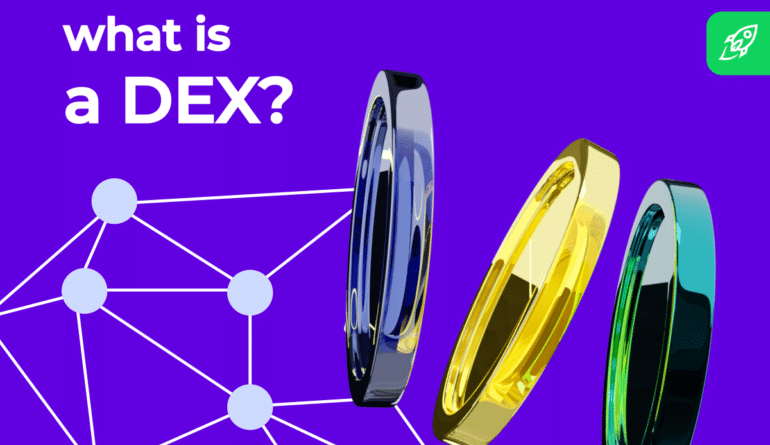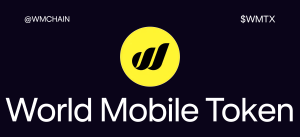What Is a DEX (Decentralized Exchange)?
Centralized platforms dominate most financial systems—but what if you could trade crypto without them? That’s exactly what decentralized exchanges (DEXs) make possible. Built on blockchain technology, DEXs let you swap tokens directly with others, without handing control to any third party. These platforms are transforming how people access digital assets, offering open, permissionless alternatives to traditional markets. In this article, you’ll learn what a DEX is, how it works, and why it plays such a crucial role in the growing world of decentralized finance.
What Is a DEX?
A DEX, or decentralized exchange, is a platform that allows you to trade cryptocurrencies directly with others. It doesn’t rely on a middleman like a bank or broker. Instead, it uses smart contracts—self-executing programs stored on a blockchain—to facilitate trading.
Think of a DEX like a farmers’ market. You walk up to a stall, see what someone is offering, and make a trade right then and there. There’s no supermarket chain overseeing the exchange. Unlike centralized exchanges, there’s no company holding your funds, verifying your identity, or charging you withdrawal fees.
DEXs are powered by liquidity providers—users who deposit their crypto into trading pools. These pools allow others to trade without needing a counterparty on the other side. The process relies on automated market makers (AMMs), algorithms that set prices based on the amount of each asset in a pool.
All you need to use a decentralized exchange is a wallet and a connection to the Internet. Once connected, you can make financial transactions directly with the protocol, without handing control of your funds to a third party.
How is a DEX different from a CEX?

A centralized exchange (CEX) is managed by a company or organization. It provides a user-friendly interface, customer support, and often more liquidity. Some CEXs hold user funds, meaning they store your crypto in company-managed wallets. Others offer non-custodial options, where you retain full control over your assets.
The key difference is how trades are executed. On a DEX, trades are peer-to-peer and powered by smart contracts. The platform doesn’t manage or store your crypto. On a CEX, even if you control your wallet, you rely on the exchange to match and process your orders.
CEXs may offer faster execution, fiat support, and advanced features. But DEXs give you greater control, privacy, and global access—there’s no need to open an account. You can just connect your wallet and start trading.
Read more: Centralized vs. Decentralized Exchanges.
Why DEXs Matter in the Crypto Ecosystem
Decentralized exchanges (DEXs) play a key role in making crypto accessible, transparent, and secure. They remove the need to trust third parties with your funds or data. This supports the core values of cryptocurrency: decentralization, privacy, and user control.
DEXs also promote financial inclusion. Anyone with a wallet and an internet connection can trade, no matter where they live or what ID they have. In regions with limited banking access, DEXs offer a powerful alternative for managing assets and performing financial transactions without restrictions.
How Do Decentralized Exchanges Work?
As we have already mentioned previously, a decentralized exchange (DEX) operates through smart contracts that automate and record trades directly on the blockchain. Unlike traditional trading platforms, a DEX doesn’t manage your funds or act as a middleman. Every trade happens between users, peer-to-peer, with no central authority in control.
The engine behind DEXs is made up of three key components: smart contracts, on-chain trading, and liquidity pools.
DEXs rely on smart contracts, self-executing code that enforces rules and processes transactions. Every trade is conducted on-chain, meaning it’s publicly recorded and verifiable on the blockchain. This ensures transparency and reduces the risk of manipulation or censorship.

To function without order books or human brokers, DEXs use liquidity pools. These are smart contract-based reserves of tokens provided by users called liquidity providers. Pools enable trading between two or more tokens using automated market makers (AMMs). The pricing is adjusted algorithmically based on the ratio of tokens in the pool.
This model makes it possible to trade 24/7 without needing someone on the other side of your order. It also removes delays, central oversight, and most barriers to entry.
How Do You Interact with a DEX?
To use a DEX, you need a non-custodial crypto wallet like MetaMask, Trust Wallet, or Rabby. You don’t need to register or provide personal data. Just connect your wallet through the DEX interface using an Internet connection.
Once connected, choose the tokens you want to trade. The DEX will automatically route your order through a liquidity pool and confirm the swap via a smart contract. You’ll approve the transaction in your wallet, and the new tokens will appear there once the transaction is complete.
Most DEXs run on specific blockchains—Uniswap, for example, runs on Ethereum—so you’ll need to pay network gas costs in the blockchain’s native token (like ETH for Ethereum).
How Do DEX Fees Work?
DEXs charge fees to cover protocol operations and reward liquidity providers. These are usually lower than centralized exchanges but vary by platform.
For example, Uniswap charges a 0.3% fee per trade, which goes directly to liquidity providers. The platform itself may take a small protocol fee, depending on governance decisions.
In addition to trading fees, users must also pay blockchain gas fees. These fees fluctuate based on network congestion and can sometimes exceed the DEX fee itself. So while trading on a DEX gives you more control and privacy, it’s important to consider timing and network conditions to minimize costs.
Become the smartest crypto enthusiast in the room
Get the top 50 crypto definitions you need to know in the industry for free

Popular Types of DEXs
Decentralized exchanges come in different shapes and sizes, each designed to facilitate trading without relying on intermediaries. While all DEXs aim to provide instant access to crypto markets, they use different mechanisms to process trades, manage assets, and support DEX users.
AMM-Based DEXs
Automated market maker (AMM) DEXs use a mathematical formula to set prices and facilitate trades. There’s no need for a buyer and seller to match orders directly. Instead, users trade against a liquidity pool, which holds tokens deposited by liquidity providers.
This system enables users to swap tokens at any time, even in the absence of active counterparties. Popular AMM-based DEXs include Uniswap, PancakeSwap, and Curve.
Order Book-Based DEXs
Order book DEXs are modeled after traditional exchanges. Users place buy and sell orders, and the platform matches them when prices align. These can operate off chain or on-chain, depending on how they store and process orders.
Some order book DEXs maintain network security while offering advanced tools like margin trading and limit orders. dYdX and Loopring are well-known examples.
Aggregator DEXs
Aggregator DEXs scan multiple platforms to find the best trade rates. They don’t host their own liquidity pools. Instead, they source from many DEXs to facilitate trading at optimal prices. This model enables users to reduce slippage and improve execution.
These platforms act like payment processors, routing trades behind the scenes while giving you a simple interface. Matcha and 1inch are leading examples.
Popular DEXs
Here’s a look at some of the most widely-used DEXs today.
Uniswap
Uniswap is one of the first and most trusted AMM-based DEXs. It runs on Ethereum and uses liquidity pools to support token swaps. Its simple interface and large user base contribute to its high liquidity. Uniswap v3 introduced concentrated liquidity, making capital usage more efficient and helping reduce slippage.
PancakeSwap
Built on the BNB Chain, PancakeSwap is known for its lower gas cost compared to Ethereum-based DEXs. It offers AMM trading, yield farming, and NFT integration. PancakeSwap is popular among users looking to explore DeFi with minimal fees and fast transaction times.
dYdX
dYdX combines decentralized trading with an order book model and advanced tools like perpetual contracts. It runs partly off-chain, which helps reduce latency and provides a more traditional trading experience while still settling trades on-chain. It’s designed for serious traders seeking leverage and precision.
Curve Finance
Curve is optimized for stablecoin swaps. By focusing on like-valued assets, it offers minimal slippage and lower gas cost for stablecoin pairs. Liquidity providers benefit from relatively stable returns, and the protocol’s design minimizes price volatility within pools.
1inch
1inch is a DEX aggregator that searches across many DEXs to find the best price for each trade. It uses smart routing to split large orders across multiple platforms when needed. This results in better execution, especially for large trades. It’s also helpful in resolving issues like price impact and liquidity fragmentation.
Are Decentralized Exchanges Safe to Use?
Decentralized exchanges are generally safe when used correctly. They operate as a peer-to-peer marketplace, so you keep control of your funds—unlike centralized exchanges, which can sometimes be vulnerable to hacks or misuse of user assets.
In the growing DeFi ecosystem, DEXs and DEX aggregators are audited regularly and run on open-source smart contracts. Still, risks exist, including bugs in the code, fake tokens, and low liquidity pools. As DEXs become increasingly popular in the cryptocurrency ecosystem, safety depends on using trusted platforms, verifying token addresses, and staying updated on protocol changes.
Advantages of DEXs
Here are the main benefits of decentralized exchanges.
- Access to unlisted tokens
DEXs allow you to trade new or niche tokens before they appear on centralized exchanges. - No KYC/AML requirements
You don’t need to submit personal information to trade, which protects your privacy and simplifies access. - Non-custodial trading
You control your funds at all times. There’s no risk of losing assets to an exchange hack or freeze. - Global accessibility
Anyone with an internet connection and a crypto wallet can use a DEX, regardless of location. - Censorship resistance
Because DEXs run on smart contracts and not servers controlled by a single entity, it’s harder for governments or corporations to block access. - Enhanced security
With no central storage of user funds, DEXs reduce the attack surface for hackers. - Access to DEX aggregators
Some platforms, especially DEX aggregators, can split orders across multiple pools to find the best route and minimize slippage.
Disadvantages of DEXs
Despite their strengths, DEXs also come with limitations that can impact user experience and security:
- Complex interfaces
DEXs often require more technical understanding than centralized platforms, especially when using wallet extensions and managing gas fees. - No customer support
If something goes wrong (like a failed transaction) there’s no help desk. You’re on your own. - Risk of smart contract bugs
Even audited code can have vulnerabilities. Bugs in the smart contracts can lead to loss of funds. - Fake or malicious tokens
Because anyone can list a token, there’s a higher chance of scams. Always verify contract addresses. - Price slippage and low liquidity
Trading low-volume tokens can result in bad prices. Slippage is more likely during volatile markets. - Counterparty risk in liquidity pools
If you provide liquidity, you could face impermanent loss or interact with tokens that quickly lose value, exposing you to financial risk even without direct fraud. - No fiat support
DEXs don’t accept traditional currencies. You’ll need to acquire crypto elsewhere before you can start trading.
Tips for Using DEXs
Using a decentralized exchange gives you full control, but it also means you have to be extra careful. Here are some practical tips to stay safe and trade efficiently.
- Double-check token contract addresses
Always verify tokens through trusted sources like CoinGecko or CoinMarketCap. Avoid tokens with similar names to well-known projects. - Use a reputable wallet
Connect only through secure, non-custodial wallets like MetaMask, Trust Wallet, or Ledger. - Start with small amounts
If you’re using a new DEX or unfamiliar token, test with a small trade before committing larger amounts. - Monitor gas fees
Check current network conditions on services like Etherscan or Gas Now. Avoid trading during peak congestion to reduce costs. - Avoid phishing sites
Bookmark official URLs and avoid clicking links from unknown sources. Fake DEX interfaces are common scams. - Revoke old permissions
Use tools like revoke.cash to remove smart contract approvals you no longer use. This helps protect your funds. - Understand liquidity
Check if the liquidity pool has enough depth to support your trade. Low liquidity increases the risk of slippage or failed transactions.
Final Words: The Future of Decentralized Exchanges
Decentralized exchanges are no longer experimental tools for developers or early adopters. In 2025, they’re a practical and widely-used way of trading cryptocurrencies across the world. With support for lower fees, direct wallet connections, and permissionless access, DEXs offer clear advantages over centralized platforms.
The technology behind how DEXs work is also improving. Layer 2 scaling, advanced routing, and smarter DEX aggregators now allow seamless trades with minimal slippage. Platforms built on the Ethereum blockchain and beyond are continuing to evolve, making decentralized trading faster, cheaper, and more accessible.

As regulation adapts and more users enter the DeFi ecosystem, DEXs will remain central to the push for open finance. They’re not just alternatives—they’re becoming the standard.
FAQ
Do I need to verify my identity (KYC) to use a DEX?
No, you don’t need to complete KYC. Most popular DEXs operate without collecting personal data, allowing users to trade freely and privately from anywhere.
How do I connect my wallet to a DEX safely?
Always connect using a trusted wallet like MetaMask or Trust Wallet. Make sure the site is legitimate and understand how DEXs work before approving any transaction.
Can I trade fiat currencies on a DEX?
No, DEXs do not support fiat directly. They operate in a decentralized manner and only handle digital assets like stablecoins or tokenized versions of fiat.
Is providing liquidity on a DEX a good way to earn passive income?
It can be, especially during high-volume periods. Liquidity providers earn a share of trading fees, and some protocols automatically match buy and sell activity to maximize earnings.
What happens if a DEX gets hacked? Will I lose my funds?
It depends on how the hack happens. If the exploit targets a pool you’ve added funds to, you could lose assets, but you’re safer if your funds stay in your wallet—this is how most DEXs work.
What is the current state of DEXs in 2025?
In 2025, the DEX space is growing fast, with Layer 2 solutions and aggregators improving speed and efficiency. Most popular DEXs now offer smoother interfaces and faster execution, allowing users to trade with confidence across multiple chains.
Disclaimer: Please note that the contents of this article are not financial or investing advice. The information provided in this article is the author’s opinion only and should not be considered as offering trading or investing recommendations. We do not make any warranties about the completeness, reliability and accuracy of this information. The cryptocurrency market suffers from high volatility and occasional arbitrary movements. Any investor, trader, or regular crypto users should research multiple viewpoints and be familiar with all local regulations before committing to an investment.
The post What Is a DEX (Decentralized Exchange)? appeared first on Cryptocurrency News & Trading Tips – Crypto Blog by Changelly.
Cryptocurrency News & Trading Tips – Crypto Blog by Changelly




















